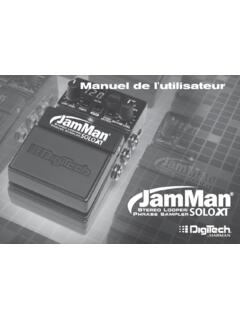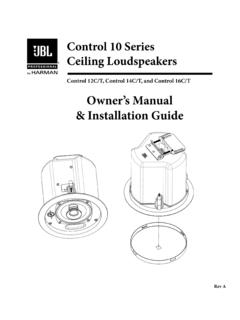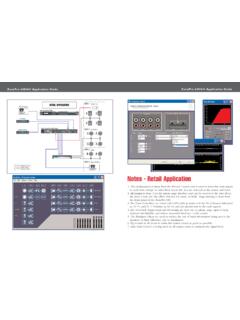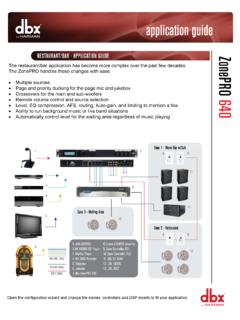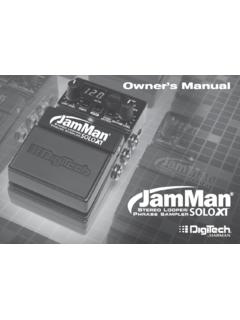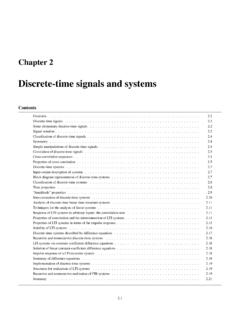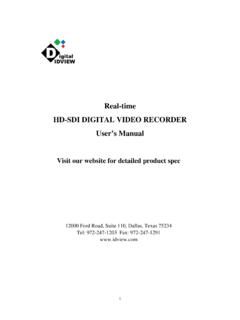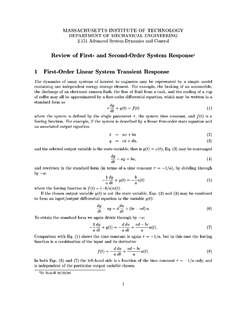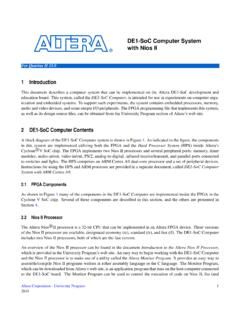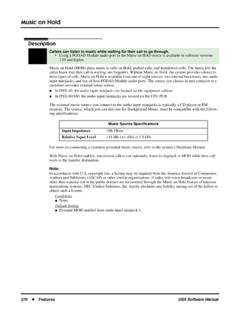Transcription of Studer Vista 8 Digital Audio Console Information
1 Studer Vista 8 Digital Audio Console Information 29th July 2004 1 2 GENERAL SYSTEM SYSTEM BLOCK Block Diagram showing system utlising D21m IO CONTROL SURFACE ( Vista 8)..4 Momentary/Latching Activation of all Fast Copy/Paste and Half-Lit Banking with Scrolling DSP input / output Available D21m Audio IO D21m Stagebox MONITORING, TALKBACK AND Talkback and EXTERNAL 3 SYSTEM SERVICE 4 Power DSP MADI Control Control Mastersync N-1 5 TECHNICAL Vista 8 CONTROL SURFACE POWER 2 1 Introduction This document outlines some of the key features of the Studer Vista 8 Digital Audio Console .
2 2 General System Overview The system structure of the Vista 8 Digital Console can be separated into 5 main areas: 1. Control Surface 2. DSP Core 3. IO 4. Monitoring & Signalling 5. External Synchronisation System Block Diagram Block Diagram showing system utlising D21m IO System Global Wiring Overview Vista 8 (with D21m I/O) Vista 8 Desk (with built-in Control System)Monitoring FrameDSP CoreOptical LinkRS485/HP/TBPFL/CR/STAES/EBU LinkTB IntAES/EBU LinkLVDS (CAT 5)Mic Control Data32 GPO48 GPIC ontrol RoomMonitoring AMonitoring2Ch(optional)Studio BMonitoring2Ch(optional)MADI (with embedded Mic Control)Option: Outputs for CustomMetersLocal IOD21m HubD21m StageboxStagebox IO(Option: Mastersync Unit)House Sync(Video, Wordclock, etc) PLEASE NOTE: This is a general System Block Diagram.
3 Actual number of D21 IO frames will depend on customer requirements. Control Surface ( Vista 8) The Control Surface of the Vista 8 is shown below (only 1 fader bay shown): The control surface features the industry acclaimed Vistonics User Interface which offers a where you look is where you control philosophy. The Studer developed Vistonics technology mounts rotary controls and switches on TFT Screens. This then offers the user the benefits of screen technology (Touchscreen, colour, icons and text) without the limitations of having to access physical controls away from the where the control is displayed. A touch and access philosophy combined with Channel strip orientated operation offers a friendly and intuitive operating concept.
4 4 This extremely intuitive and fast to learn operational concept is further enhanced by 4 other key operational features that frees the users mind from working on the Console and allows more thought to be placed on the work at hand. These key features are: Momentary/Latching Activation of all Buttons The Console recognizes and senses the button-push duration and responds accordingly. The buttons therefore act momentarily or latchingly depending on how they were pressed (pressed-and-held or briefly tapped). In addition to Talkback, PFL, EQ on/off, etc., the functions affected include those accessed by the touch-screen - such as viewing of Audio function - as well as the monitoring source selectors and the machine control.
5 Ganging The ganging function in the mixer allows the operator to quickly apply functions to multiple channel strips because channels within the gang act as one. This can be used, for example, for Mute, Automation mode changes, faders, Bus assign and much more to increase speed and comfort in operation. Creating a gang over the Console makes the set-up quick and easy. Fast Copy/Paste and Half-Lit Keys The Console incorporates dedicated copy/paste keys for each Audio function including EQ, dynamics, panorama and delay. A simple button-press in the original channel and another in the target channel copies the settings across.
6 Copy/Paste is guided up by the half-lit buttons: if one button has been pressed and the desk is awaiting a second button-press, all available target buttons illuminate at half brightness until one of them has been selected. Also, complete channels can be cloned to one or many target channels. Setting up the Studer Vista 7 for a production becomes a quick and easy task. Non-productive time is reduced considerably. Banking with Scrolling Navigation DSP channels not visible on the physical desk are accessed by scrolling the channels available in the DSP core. The channel order is freely assignable: channels can be grouped or even shown repeatedly on the surface.
7 This ensures physical orientation on the desk so that the operator is always clearly informed as to what is happening. Channel Bays with, for example, the master channels can also be locked in place. The Vista 8 also includes a completely redesigned Control Bay. While talkback and monitoring functionality, trackball and a motorized joystick have been maintained from the previous Vista consoles, dedicated control elements have been introduced for operation of outputs. 12 motorized 5faders and a Vistonics screen with 40 rotaries have been added. Multiple user definable assignments of these 12 faders and Vistonics controls are possible to be recalled by one button press, giving up to 52 directly accessible level controls for controlling all sorts of outputs such as master, groups or matrix outputs.
8 Two of the faders will act as grand masters without alternate pages, allowing instant influence on all Console outputs if needed. The other 10 fader strips as well as all 40 rotaries with their pushbuttons will allow also SOLO/PFL, MUTE as well as TALKING to each masters individually. Metering has also been extended: 40 meters are visible on the Vistonics and the corresponding level controls are immediately available on the rotary controls next to them. Looking at levels and correcting them therefore is just a fraction of a second away. Another major improvement is the reverse operation of masters and their busses.
9 Vista 8 can show all channels contributing to a specific master bus on the Vistonics screen and allows level adjustment of all those channels instantly - without physically accessing the contributing channels themselves on the fader bay. Furthermore the control group functionality (VCA style) will be extended to form control groups with different levels of control (hierarchical control groups). Each channel strip allows the possibility to flip a single fader to a second layer without flipping the whole Console . Dynamic Automation is also a feature of the desk. You can boot the desk in one of two modes; Snapshot automation for live on-air or dynamic automation for production use.
10 New dual colour metering is provided on each channel to give better headroom indication which is definable. DSP Core The DSP core of the Studer Vista 8 builds on Studer s well-proven Digital technology. It incorporates an excellent reliability record and inspires a high degree of confidence enjoyed by the numerous users operating systems in mission-critical applications. The DSP core uses parallel processing architecture with integrated floating point circuitry and an internal word length of 40 bits. No overloads will ever occur within the Console , since floating point architecture is even used in the summing busses.

